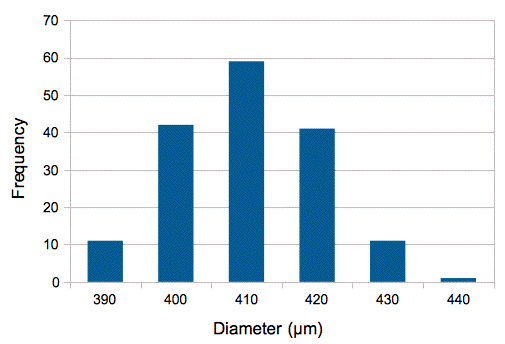The fiber is divided into 178 sections, each 9 m long, so that the total length of fiber is around 1600 m. We took a 10-cm sample from each 9-m section and measured its diameter. Of these, 165 had diameter 390-440 μm, and 13 had diameter 130-310 μm. We set aside the thinner fibers and consider the 165 larger fibers. The histogram below shows the distribution of their diameters.

Figure: Distribution of Section Diameter
We were hoping for an average diameter of 440 μm and a range of 400-480 μm. What we have is an average diameter of 411 μm with range 390-440 μm, which is similar to the distribution of our previous high-index fiber.
From the 1600 m of fiber we have 100 m with diameter 430 μm or higher. We need 50 mm to make one 8-mm fiber taper, so we have enough fiber in stock to make two thousand fiber tapers of base diameter 430 μm. According to our calculations, the 430 μm diameter should capture and transport 64% of the light emitted by an EZ500 LED. With 30 mA of LED current and 28 mW of blue light emitted, we are hoping to see 18 mW at the fiber tip.
UPDATE: [28-JUN-13] We find a piece of TD5 fiber with diameter 450 μm. We polish both ends of a 80-mm length. We cover 20 mm of the fiber with nail polish. We run 30 mA through an EZ500 460-nm blue LED and obtain 31 mW emitted power. We lower the fiber onto the LED and obtain 16 mW at the fiber tip, which is 50% capture efficiency, and consistent with our earlier calculations for a fiber of numerical aperture 1.72 and diameter 450 μm.
No comments:
Post a Comment